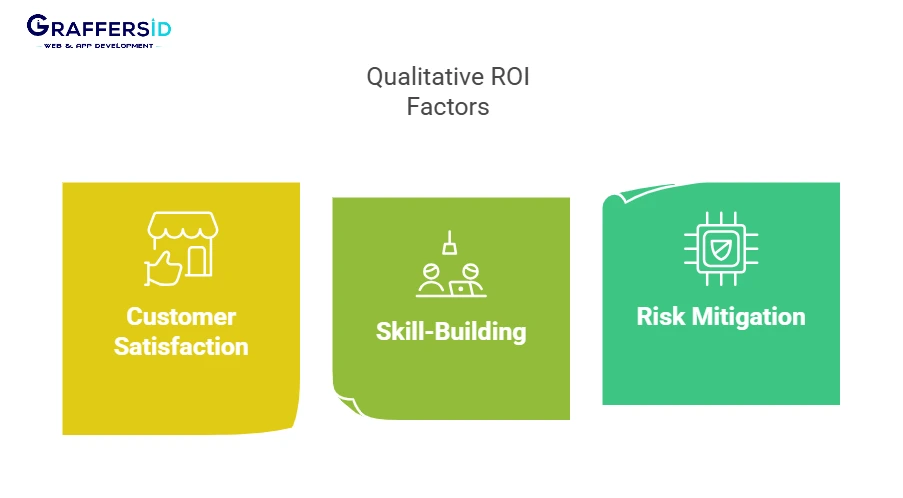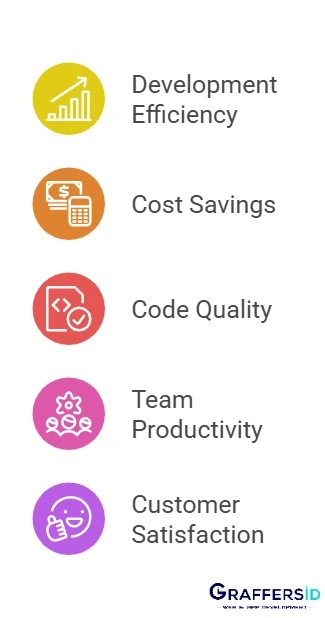Offshore development is a great strategy for businesses that want to cut costs in their development projects without compromising the quality. However, founders might not be able to understand the true Return on Investment (ROI) goes beyond just salaries. In order to evaluate offshore development pricing holistically, it is important to consider direct and indirect costs, revenue impact, qualitative benefits, and long-term performance metrics.
In this article, we will break down key factors that influence offshore development costs and provide a structured approach to measuring ROI.
Read Also: Staff Augmentation vs Outsourcing-Which is Right For You?
Calculating Direct and Indirect Costs
There are several costs associated when calculating the ROI of offshore development that have to be taken into consideration. There are certain direct costs like salaries and infrastructure, indirect costs like training and overhead, and some other costs like benefits, accommodation, bonuses, etc.
Direct Costs
These are the first costs to be taken into consideration when evaluating offshore development pricing, as they are the most obvious expenditures. These include:
- Developer Salaries – When you hire offshore teams, the developers cost you only a fraction of the amount that you would usually pay when hiring local talent. This is one of the biggest costs to a company, and hiring remote developers can be very cost-effective.
- Infrastructure and Tools – There are certain infrastructure and tool considerations like cloud services, development tools, and project management software that are big costs.
- Contractor Fees – A certain cut in the costs goes towards the offshore development centers or third-party vendors that will facilitate the process of remote hiring.
Indirect Costs
- Onboarding and Training – Costs do not need to just be in monetary terms. Time spent is also a cost, and the time invested in bringing offshore developers up to speed is an indirect cost.
- Communication Expenses – Costs of purchasing communication tools like Slack, Zoom, or any other management overhead.
- Legal and Compliance Costs – Costs associated with securing your data, contracts, and regulatory requirements are also indirect expenses that need to be considered.
Comparing Costs: Offshore vs. In-House Development
Cost Factor |
Offshore Development |
In-House Development |
Developer Salaries |
Lower rates in offshore markets | Higher salaries in developed markets |
Infrastructure |
Shared cloud resources, reduced office expenses | Office rent, hardware, and local IT costs |
Onboarding & Training |
Moderate, varies by vendor | High, due to long-term investments |
Compliance Costs |
Can be managed through outsourcing vendors | Higher due to local labor laws |
Overall Cost |
Typically 40-60% lower than in-house development | Higher due to direct hiring and operational expenses |
Businesses that analyze these costs accurately can make informed decisions about offshore development pricing and assess the long-term savings.
Measuring Revenue Impact
Offshore development provides a lot of revenue benefits apart from cost savings as well. It accelerates software releases, improves product quality, and optimizes business operations.
Faster Time-to-Market
- 24/7 Development Cycle – Since offshore teams are distributed globally, they can operate in different time zones. This can allow them to continue their development cycles even after local teams log off.
- Agile Development Practices – Several offshore teams specialize in Agile and DevOps which reduces development cycle time and fastens product launches.
- Scalability – With offshore teams, you can choose to scale up and down very quickly as compared to the tedious hiring process you would have to go through when looking for local talent.
Higher Quality Leads & Better Customer Retention
Offshore development enables:
- Better Feature Implementation – With offshore development centers, you can access Advanced AI, automation, and personalization features that eventually improve user experience.
- Continuous Product Improvements – Iteration cycles are faster which helps in the development of superior software products.
- Competitive Advantage – A well-developed product can attract more leads, increasing conversion rates.
Revenue Impact Analysis
Revenue Impact Factor |
Contribution of Offshore Development |
Faster time-to-market |
Reduces development cycles by 30-50% |
Higher software quality |
Improves user retention and reduces churn |
Enhanced scalability |
Enables rapid expansion to meet business demands |
Cost-effectiveness |
Enables reinvestment into product development |
Qualitative ROI Factors
Once you’ve considered the cost and revenue impact, you should look at the qualitative factors. These factors play a crucial role in determining offshore development ROI.

Customer Satisfaction
A well-built application results in:
- Seamless User Experience – With faster performance, fewer bugs, and improved security, you can improve the user experience.
- Better Support & Maintenance – With offshore teams, there is round-the-clock support, faster issue resolution, and shorter development cycles.
Skill-Building & Team Productivity
Offshore teams contribute to:
- Access to Global Talent – When opting for offshore teams, you get access to diverse skill sets and specialized expertise with global talent.
- Internal Team Focus – With your development work outsourced, the in-house teams can put all their focus on innovation and strategy rather than maintenance tasks.
- Collaboration Efficiency – With advanced communication tools, your developers can seamlessly collaborate and integrate with in-house teams.
Risk Mitigation
It is important to manage certain potential risks like security vulnerabilities, miscommunication, and project delays associated with offshore development.
- Regular Compliance Checks – Several compliance checks need to be abided by. Ensure that offshore teams follow data protection regulations like GDPR and HIPAA.
- Clear Communication Guidelines – Set clear communication channels that will allow for uninterrupted workflow and no misunderstandings.
- Hybrid Models – Let your offshore teams and in-house teams collaborate and balance control for efficient workflows.
By assessing these qualitative factors, your business will be able to make strategic long-term decisions instead of just focusing on short-term offshore development costs.
Continuous Performance Tracking
To get your money’s worth, do not stop evaluating the team after implementation. Set performance metrics and conduct regular assessments that will help in understanding the progress of the teams.

Key Performance Indicators (KPIs) for Offshore Development
| KPI | Measurement Criteria |
| Development Efficiency | Number of completed sprints, cycle time |
| Cost Savings | Reduction in overhead, infrastructure costs |
| Code Quality | Bug density, security vulnerabilities detected |
| Team Productivity | Task completion rates, hours spent per project |
| Customer Satisfaction | User feedback, Net Promoter Score (NPS) |
Setting Up Performance Reviews
- Quarterly Reviews – Keep track of the financial and operational progress.
- Code Audits – To maintain quality in your software development, conduct regular assessments.
- Client Feedback Loops –Ensure user satisfaction by using surveys, analytics, and continuous feedback.
If closely monitored, offshore development pricing can be evaluated properly to reveal the ROI. Structured metrics can let businesses maximize the value of their outsourcing strategy.
Final Thoughts
By taking a smart and comprehensive approach, you can understand the true ROI of offshore development which goes beyond cost comparisons. Although offshore development costs are comparatively lower than in-house hiring, the benefits go beyond that- faster product launches, improved software quality, and access to global talent.
If you are looking to hire an offshore development center for software and web development, you should try us at GraffersID. We have the best developers on board who are ready to assist you- from ideation to kick-off. Contact us today and bring your vision to life!





